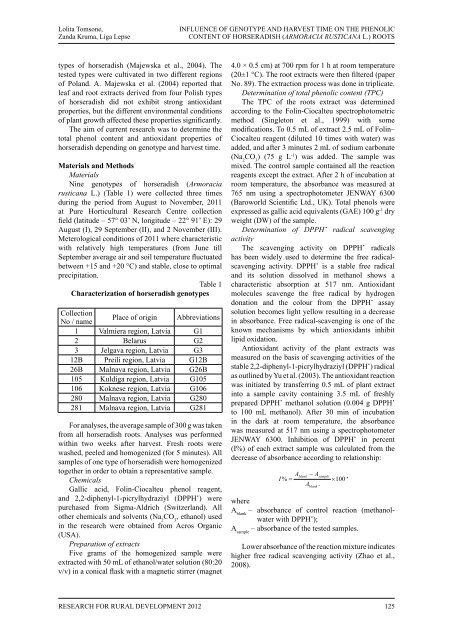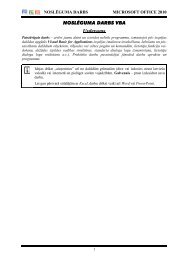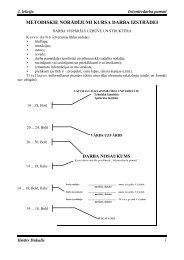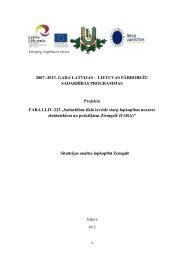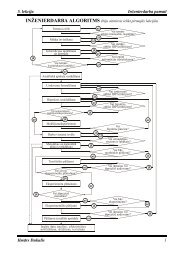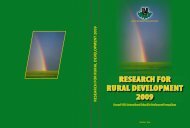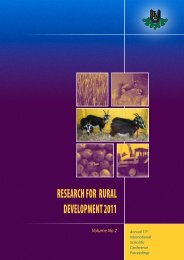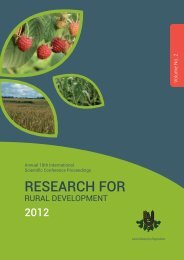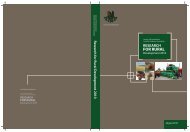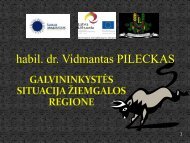LATVIA UNIVERSITY OF AGRICULTURE - Latvijas ...
LATVIA UNIVERSITY OF AGRICULTURE - Latvijas ...
LATVIA UNIVERSITY OF AGRICULTURE - Latvijas ...
- No tags were found...
You also want an ePaper? Increase the reach of your titles
YUMPU automatically turns print PDFs into web optimized ePapers that Google loves.
Lolita Tomsone,Zanda Kruma, Liga LepseINFLUENCE <strong>OF</strong> GENOTYPE AND HARVEST TIME ON THE PHENOLICCONTENT <strong>OF</strong> HORSERADISH (ARMORACIA RUSTICANA L.) ROOTStypes of horseradish (Majewska et al., 2004). Thetested types were cultivated in two different regionsof Poland. A. Majewska et al. (2004) reported thatleaf and root extracts derived from four Polish typesof horseradish did not exhibit strong antioxidantproperties, but the different environmental conditionsof plant growth affected these properties significantly.The aim of current research was to determine thetotal phenol content and antioxidant properties ofhorseradish depending on genotype and harvest time.Materials and MethodsMaterialsNine genotypes of horseradish (Armoraciarusticana L.) (Table 1) were collected three timesduring the period from August to November, 2011at Pure Horticultural Research Centre collectionfield (latitude – 57° 03’ N, longitude – 22° 91’ E): 29August (I), 29 September (II), and 2 November (III).Meterological conditions of 2011 where characteristicwith relatively high temperatures (from June tillSeptember average air and soil temperature fluctuatedbetween +15 and +20 °C) and stable, close to optimalprecipitation.Table 1Characterization of horseradish genotypesCollectionNo / namePlace of origin Abbreviations1 Valmiera region, Latvia G12 Belarus G23 Jelgava region, Latvia G312B Preili region, Latvia G12B26B Malnava region, Latvia G26B105 Kuldiga region, Latvia G105106 Koknese region, Latvia G106280 Malnava region, Latvia G280281 Malnava region, Latvia G281For analyses, the average sample of 300 g was takenfrom all horseradish roots. Analyses was performedwithin two weeks after harvest. Fresh roots werewashed, peeled and homogenized (for 5 minutes). Allsamples of one type of horseradish were homogenizedtogether in order to obtain a representative sample.ChemicalsGallic acid, Folin-Ciocalteu phenol reagent,and 2,2-diphenyl-1-picrylhydraziyl (DPPH˙) werepurchased from Sigma-Aldrich (Switzerland). Allother chemicals and solvents (Na 2CO 3, ethanol) usedin the research were obtained from Acros Organic(USA).Preparation of extractsFive grams of the homogenized sample wereextracted with 50 mL of ethanol/water solution (80:20v/v) in a conical flask with a magnetic stirrer (magnet4.0 × 0.5 cm) at 700 rpm for 1 h at room temperature(20±1 °C). The root extracts were then filtered (paperNo. 89). The extraction process was done in triplicate.Determination of total phenolic content (TPC)The TPC of the roots extract was determinedaccording to the Folin-Ciocalteu spectrophotometricmethod (Singleton et al., 1999) with somemodifications. To 0.5 mL of extract 2.5 mL of Folin–Ciocalteu reagent (diluted 10 times with water) wasadded, and after 3 minutes 2 mL of sodium carbonate(Na 2CO 3) (75 g L -1 ) was added. The sample wasmixed. The control sample contained all the reactionreagents except the extract. After 2 h of incubation atroom temperature, the absorbance was measured at765 nm using a spectrophotometer JENWAY 6300(Baroworld Scientific Ltd., UK). Total phenols wereexpressed as gallic acid equivalents (GAE) 100 g -1 dryweight (DW) of the sample.Determination of DPPH˙ radical scavengingactivityThe scavenging activity on DPPH˙ radicalshas been widely used to determine the free radicalscavengingactivity. DPPH˙ is a stable free radicaland its solution dissolved in methanol shows acharacteristic absorption at 517 nm. Antioxidantmolecules scavenge the free radical by hydrogendonation and the colour from the DPPH˙ assaysolution becomes light yellow resulting in a decreasein absorbance. Free radical-scavenging is one of theknown mechanisms by which antioxidants inhibitlipid oxidation.Antioxidant activity of the plant extracts wasmeasured on the basis of scavenging activities of thestable 2,2-diphenyl-1-picrylhydraziyl (DPPH˙) radicalas outlined by Yu et al. (2003). The antioxidant reactionwas initiated by transferring 0.5 mL of plant extractinto a sample cavity containing 3.5 mL of freshlyprepared DPPH˙ methanol solution (0.004 g DPPH˙to 100 mL methanol). After 30 min of incubationin the dark at room temperature, the absorbancewas measured at 517 nm using a spectrophotometerJENWAY 6300. Inhibition of DPPH˙ in percent(I%) of each extract sample was calculated from thedecrease of absorbance according to relationship:Ablank− Asample,I% =× 100A .blankwhereA blank– absorbance of control reaction (methanolwaterwith DPPH˙);A sample– absorbance of the tested samples.Lower absorbance of the reaction mixture indicateshigher free radical scavenging activity (Zhao et al.,2008).Research for Rural Development 2012125


